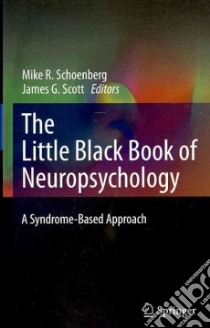- Libreria
- >
- Libri in lingua
- >
- Medicina
- >
- Neurologia e neurofisiologia clinica
The Black Book of Neuropsychology - 9780387707037
Un libro in lingua di Schoenberg Michael R. Scott James G. edito da Springer Verlag, 2011
- € 82.30
- Il prezzo è variabile in funzione del cambio della valuta d’origine
This book provides a concise yet academically rigorous overview of clinical neuropsychology from a presenting syndrome or symptoms approach. Because clinical neuropsychology practice necessitates an understanding of functional neuroanatomy, a basic review is provided along with a description of a basic neurobehavioral examination. This book is not meant to supplant the longer, more encompassing texts of clinical neuropsychology or neurology. Rather, it supplements these textbooks as a concise and user-friendly reference guide. The unifying thread for this book is the practical approach to assessing a clinical problem (sign, symptom, or complaint) and applying an algorithmic rationale to the associated brain-behavior relationship. Thus, it is designed to be a practical book for the daily practice of clinical neuropsychology.The first part of the book discusses the importance of identifying the nature and questions of a neuropsychological referral. Generally, a clinical evaluation of neuropsychological functioning is guided by the nature of the referral. Next is provided a brief review of medical records, both in terms of reading and understanding a medical chart to important considerations in providing neuropsychological results and conclusions. The next section provides an overview of principals in neurology and functional neuroanatomy along with the basic components of a neuropsychological evaluation. The next section addresses specific, common neuropsychological complaints and disorders. Each chapter covers a specific neuropsychological domain (e.g., arousal, attention, or memory) with (1) a description of the neuropsychological aspects of this domain (e.g., divided, sustained, and focused attention), (2) how these deficits may be detected at the bedside or using outpatient assessment instruments, and (3) some possible etiologies for the observed behaviors. The next section takes a more classic approach to neuropsychological evaluation, presenting neuropsychological material according to specific neurological diseases (e.g., dementia, epilepsy, Parkinson's disease) and includes a brief overview of the clinical presentation, neuroanatomical correlates, and common neuropsychological findings of these syndromes. The final section of the main text includes brief discussions about professional issues involving the limitations of neuropsychological assessment, guidelines for answering referral questions, and special considerations with children and geriatric populations. Last is a concise appendix of practical information.
Informazioni bibliografiche
- Titolo del Libro in lingua: The Black Book of Neuropsychology
- Sottotitolo: A Syndrome-based Approach
- Lingua: English
- Autori : Schoenberg Michael R. Scott James G.
- Editore: Springer Verlag
- Collana: Springer Verlag (Hardcover)
- Data di Pubblicazione: 13 Gennaio '11
- Genere: PSYCHOLOGY
- Pagine: 968
- ISBN-10: 0387707034
- EAN-13: 9780387707037


